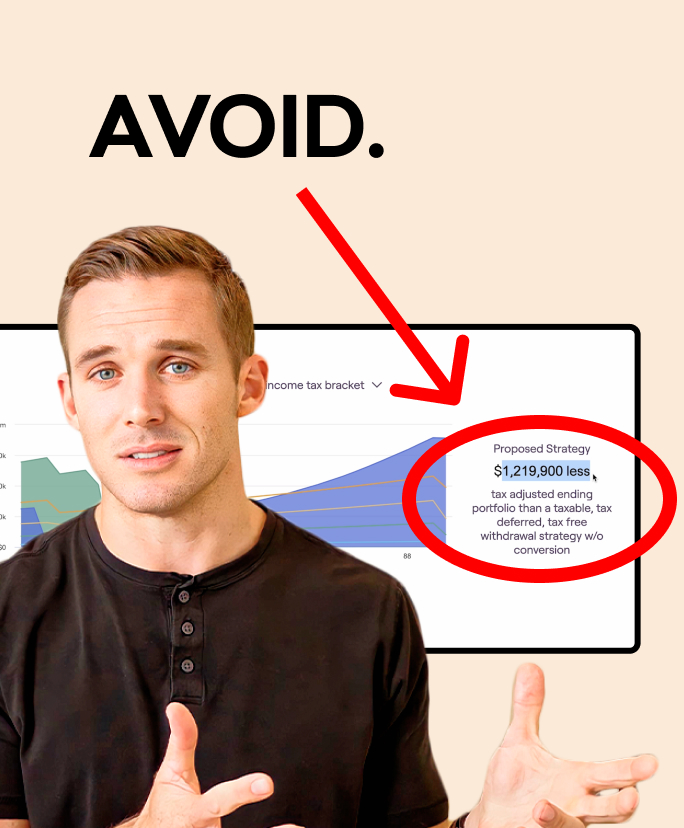We spend a lot of time talking about building Roth IRAs—through direct contributions, backdoor strategies, or Roth conversions. And for good reason. The idea of tax-free growth and tax-free withdrawals in retirement is incredibly appealing.
But here’s the part that often gets overlooked: at some point, you need to start spending your Roth IRA. The real value of that account doesn’t come from watching the balance grow indefinitely—it comes from knowing how and when to use it as part of your broader retirement strategy.
So let’s dig into a question I hear a lot: When should I start pulling money from my Roth IRA? It turns out, the answer is less about age or account balance and more about your overall tax picture.
Start With a Long-Term Tax Projection
Before deciding whether to withdraw from your Roth IRA, the first step is understanding your long-term tax outlook. Not just this year’s tax bracket—but what your taxable income might look like 5, 10, or 20 years from now.
Let’s say you’re 65 years old and recently retired. Right now, your income might be relatively low. Maybe you’re living off of a mix of cash savings, brokerage accounts, or small IRA withdrawals. But that likely won’t last forever.
Eventually, Social Security will kick in. Required minimum distributions (RMDs) from your traditional IRA or 401(k) accounts will begin (typically at age 73 or later, depending on your birth year). Add in interest, dividends, and maybe even pension income, and your tax bracket in your 70s and beyond could be significantly higher than it is today.
This creates what I often refer to as a tax planning window—a period of time between retirement and when RMDs and full Social Security benefits begin. During this window, your taxable income may be unusually low, and that gives you more flexibility.
The Key Question: Where Will Your Tax Bracket Be Higher?
If you expect to be in a higher tax bracket in the future, it usually makes sense to delay pulling from your Roth. Instead, you might draw more from your traditional IRA or even do Roth conversions to fill up lower tax brackets today—knowing that this reduces the tax burden of future RMDs.
On the other hand, if your future tax bracket is likely to be lower, spending from your Roth IRA today could be the smarter move. Why? Because using Roth dollars now avoids paying 22% or 24% tax rates today, when your future self might only owe 12% on withdrawals from your IRA.
In other words, your Roth IRA is most valuable when it saves you from high taxes—not when it duplicates the benefits you’d already get from low taxable income.
Set a Tax Threshold
One useful strategy is identifying a tax threshold—a marginal tax rate you’re comfortable paying. For example, maybe you decide that you’re willing to pay taxes on IRA withdrawals up to the top of the 12% bracket, but no more.
In a year where you need to spend more (say, for a big trip or home project), you could pull from your traditional IRA up to that threshold. Then, instead of going deeper into higher tax territory, you’d use your Roth IRA to cover the rest—keeping your tax bill under control.
This blend of traditional and Roth withdrawals helps you stay within your desired tax bracket, smooth out your long-term tax liability, and make strategic use of the tax-free nature of Roth income.
Situations Where Spending Roth IRA Funds Makes Sense
There are a few specific cases where it can be especially beneficial to spend your Roth IRA earlier rather than later:
- RMDs Won’t Be a Problem
If your required distributions later in life won’t force you into higher tax brackets, there may be less reason to preserve your Roth for future use. In that case, it may make sense to use Roth dollars today, particularly in higher-income years or when trying to manage Medicare premiums or taxable Social Security benefits. - You’re Trying to Smooth Out Taxes
Blending withdrawals from traditional IRAs and Roth IRAs can help you avoid jumping between tax brackets. If you’re single and need $80,000, pulling $63,000 from your IRA and the rest from your Roth might keep you below the 22% bracket, as opposed to taking the entire $80,000 from your traditional IRA and pushing yourself into a higher tax tier. - Your Heirs Are in Lower Tax Brackets
Roth IRAs are often viewed as great tools for legacy planning—but if your heirs are in a much lower tax bracket than you, it might not be the best strategy to pass your Roth assets to them. Instead, you may benefit more by using Roth funds yourself, while letting your traditional accounts go to beneficiaries who won’t pay as much in taxes on those distributions. - You Plan to Leave Assets to Charity
Charities don’t pay taxes. So if you’re leaving money to a charity, it’s usually better to give them traditional IRA funds. That allows you to spend your Roth IRA dollars and preserve the tax-free benefit for yourself. You can even give directly from your IRA while living using qualified charitable distributions (QCDs) after age 70½ to avoid taxes on those gifts.
Think of Your Roth IRA as “Tax Insurance”
Here’s how I like to think about it: your Roth IRA is like tax insurance.
You might spend years doing Roth conversions and building up that tax-free bucket of money—and then end up not needing it. Maybe tax rates don’t rise. Maybe your RMDs stay manageable. Maybe your income stays in the 12% bracket forever.
Does that make your Roth IRA a waste? Not at all.
Just like we buy insurance hoping never to use it, we build Roth accounts as protection. If tax rates do rise or your financial situation shifts unexpectedly, having tax-free money to fall back on can be a game-changer.
Final Thoughts
There’s no one-size-fits-all answer to when you should spend your Roth IRA. It depends on your income, your future tax outlook, your goals, and your beneficiaries.
But with smart planning—and by viewing your Roth as a flexible tool, not just a growing balance—you can make strategic decisions that improve your retirement and increase your peace of mind.
If you’ve been focused on building your Roth, now may be the time to start thinking just as intentionally about how to use it.
The information presented is for educational and informational purposes only and should not be construed as personalized investment or financial advice. The content discusses general retirement planning strategies and is not intended to recommend any specific course of action for any individual.
Social Security claiming strategies involve a number of variables, including life expectancy, portfolio returns, tax considerations, and personal circumstances. Decisions regarding Social Security benefits should be made in consultation with your financial advisor, taking into account your full financial picture.
Examples provided are hypothetical and for illustrative purposes only. They do not reflect any specific client situation and should not be relied upon for investment decision-making. Past performance of investments is not indicative of future results. All investing involves risk, including the potential loss of principal.
Root Financial Partners, LLC provides tax planning as part of its financial planning services. However, we do not provide tax preparation services, represent clients before the IRS, or offer legal advice.
Clients should consult their CPA or attorney before implementing any tax or legal strategies discussed. Nothing in this video should be interpreted as a recommendation to take a specific tax position or legal action.
This content may include discussions around advanced financial planning strategies such as Roth conversions, backdoor Roth IRAs, tax loss harvesting, charitable giving, estate planning tactics, or Social Security claiming strategies. These concepts are general in nature and are not personalized advice. Actions related to these strategies may trigger tax consequences or legal implications. Always consult with your CPA or attorney to assess suitability based on your personal financial circumstances.
Suitability for these strategies depends on your individual tax situation, income, age, investment profile, estate plan, and other factors. Actions related to these strategies may trigger tax consequences or legal implications. Always consult with your CPA or attorney to assess suitability based on your personal financial circumstances.


